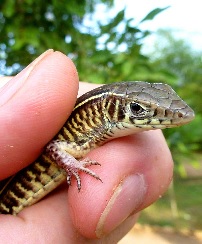Yellow-Throated Plated Lizard (Gerrhosaurus flavigularis)
Description: A ground-living and burrowing lizard, this species is usually greenish-grey or brownish, with a yellow (or sometimes red) throat and often a narrow stripe down each side. It is well armored, with hard body plates, and head shields fused to the skull. The tail is generally about two-thirds of the total length. Its limbs are well-developed, though its four five-toed feet are not specially adapted for digging. These lizards mate during the summer. In mating season the males head change color to either red, yellow or even light blue.
Habitat: This terrestrial, diurnal lizard is known from woodland, moist and dry savanna, and from coastal bush to montane grassland. It is tolerant of both farming and human habitation. It is secretive and makes use of a variety of shelter sites, including hollow logs, leaf piles, holes, and beneath large rocks .
Range: It has been intorduced into Calfornia. This widespread lizard ranges from Ethiopia, southern Somalia (with a northern range limit in Middle Shebelli) and eastern Southern Sudan to South Africa. In East Africa, it is widespread in central and southeastern Kenya, through Rwanda and Burundi south to Lake Rukwa, and in eastern Tanzania (except the southeast). It appears to be almost absent from dry northeastern Kenya and is known from Uganda only from the area between Kaabong and Moroto along the northern border.
Found in these States:
CA
Diet: The yellow-throated plated lizard is an opportunistic omnivore and different lizards have different tastes. For the most part they eat insects. Occasionally they will take fruits or vegetables.
Reproduction: The female plated lizard lays clutches of four or five eggs in a shallow pit which she excavates. Clutches of 3–8 eggs are laid in humid places, such as moist holes or leaf litter in shade. In captivity one female was observed to lay three clutches each of 5 eggs in February, March and May.
Status: Listed as Least Concern on the basis that this species is widespread and not thought to be subject to major threats, although the species is collected for the international pet trade.
»» Kingdom: Animalia - Animals
»» Phylum: Chordata - Chordates
»» Subphylum: Vertebrata - Vertebrates
»» Class: Reptilia - Reptiles
»» Order: Squamata - Lizards
»» Family: Anguidae - New World Lizards
»» Genus: Gerrhosaurus
»» Species: Gerrhosaurus flavigularis - Yellow-Throated Plated Lizard
»» Subspecies: None
This article uses material from the Wikipedia article "Yellow-Throated Plated Lizard", which is released under the Creative Commons Attribution-Share-Alike License 3.0. Content may have been omitted from the original, but no content has been changed or extended.
|








